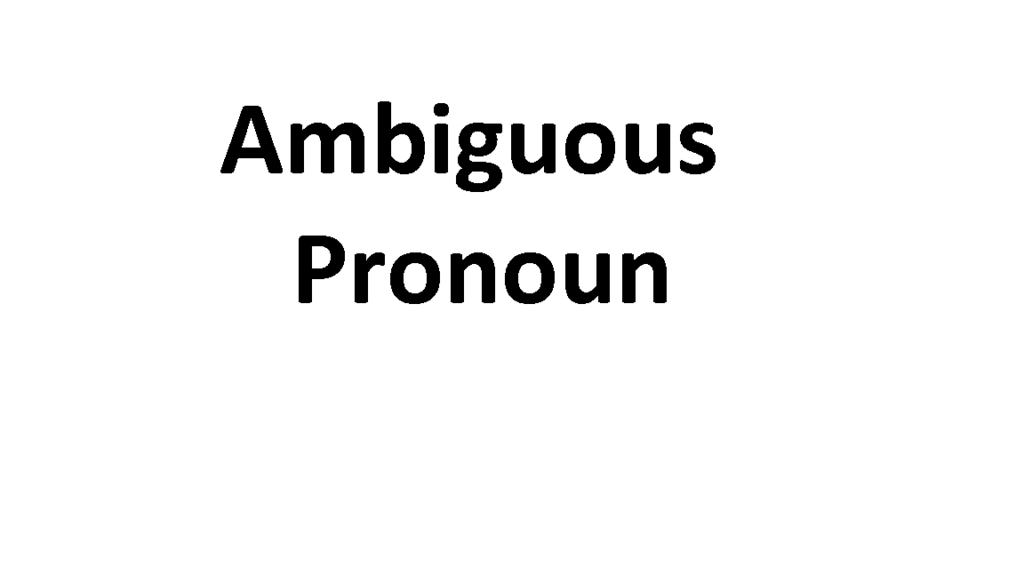Ambiguous pronoun ACT, Digital SAT, and Egyptian Scholastic test -EST
An ambiguous pronoun is an easy question in ACT, Digital SAT, and EST, do not waste it. But before we start, what is ambiguous pronoun? it refers to a pronoun that lacks clarity or precision in identifying its antecedent, which is the noun or noun phrase that the pronoun refers to.in other words, a pronoun cannot point clearly to a noun. Example, Amanda is a tall girl, so she can reach the cupboard. The word she clearly refers for Amanda in the previous example. When a pronoun is ambiguous, it can lead to confusion or misunderstandings in communication. It is important to use pronouns in a way that clearly indicates the intended referent.
Here’s a more detailed explanation of ambiguous pronouns in ACT, Digital SAT, and EST, along with examples:
1. Lack of clarity in number:
Lack of clarity in number is a sort of ambiguous pronoun.
Example: “The students were late, so they were given detention.”
In this sentence, it is unclear whether “they” refers to all the students or just some of them, so it is an ambiguous pronoun in ACT, Digital SAT, or EST. To avoid ambiguity, the sentence could be revised as follows:
Revised: “The students were late, so those who were tardy were given detention.”
2. Lack of clarity in gender:
One of the common error related to ambiguous is the lack of clarity in gender reference.
Example: “Alex asked Sarah for a favor, but she declined.”
In this sentence, it is unclear whether “she” refers to Alex or Sarah, so so it is an ambiguous pronoun in ACT, Digital SAT, or EST. To avoid ambiguity, the sentence could be revised as follows:
Revised: “Alex asked Sarah for a favor, but Sarah declined.”
3. Lack of clarity in reference:
The most important point in ambiguous and the most tested in ACT, Digital SAT, EST, or nearly all of the standardized tests is the lack of clarity in reference.
Example: “John told Mark that he should study harder.”
In this sentence, it is unclear who “he” refers to, John or Mark. To avoid ambiguity, the sentence could be revised as follows:
Revised: “John told Mark that Mark should study harder.”
4. Lack of clarity in proximity:
A proximity explanation typically refers to providing a description or clarification based on the proximity or closeness of certain elements or concepts. It often involves explaining the relationship or connection between things that are near each other.
Combining the two, an “ambiguous lack of clarity in proximity explanation” could refer to a situation where an attempt is made to explain the relationship or connection between elements, but the explanation itself is unclear, open to different interpretations, or lacks a precise definition.
Example 1:
Let’s say you’re trying to explain the concept of “social media influence” to someone, and you say, “Social media influence is the impact individuals have on others through their online presence.” This explanation is ambiguous because it doesn’t clarify whether the impact is positive or negative, or how exactly it is measured. It lacks clarity in terms of defining the nature and extent of the influence.
Example 2:
Suppose you’re reading an article about a scientific study that claims, “The proximity of certain chemicals in the environment leads to adverse health effects.” However, the article fails to provide specific details about which chemicals, their concentrations, or the exact health effects observed. This explanation lacks clarity by leaving the reader uncertain about the specific chemicals involved, the degree of exposure, and the precise health outcomes.
In both examples, the proximity explanations attempt to establish a connection or relationship between elements, but the lack of clarity makes the explanations ambiguous and subject to different interpretations.
Ambiguous pronoun examples
Example 1:
“John told Mark that he should study harder.”
Explanation: In this sentence, it is unclear whether “he” refers to John or Mark. It could mean that John advised Mark to study harder, or it could mean that John advised himself to study harder. The lack of clarity in the pronoun reference makes the sentence ambiguous.
Example 2:
“Sara and Lisa went shopping, and she bought a new dress.”
Explanation: The pronoun “she” is ambiguous because it is unclear whether it refers to Sara or Lisa. It could mean that Sara bought a new dress, or it could mean that Lisa bought the dress. The sentence lacks clarity in specifying which person the pronoun is referencing.
Example 3:
“The CEO told the managers that they need to improve their performance.”
Explanation: In this sentence, the pronoun “they” is ambiguous because it is unclear whether it refers to the CEO or the managers. High-level students can analyze the context and consider different interpretations. They can discuss the potential implications of the ambiguity on communication and expectations within the organization.
Example 4:
“The author said the protagonist’s decision surprised him.”
Explanation: The pronoun “him” is ambiguous in this sentence because it does not specify whether it refers to the author or another character in the story. High-level students can analyze the narrative, character dynamics, and the author’s perspective to explore the potential interpretations and discuss the impact of the ambiguity on reader engagement.
Example 5:
“The scientist conducted experiments, and she published her findings.”
Explanation: In this sentence, the pronouns “she” and “her” are ambiguous as they do not clearly indicate whether they refer to the scientist or another female researcher. High-level students can examine the scientific community, gender representation, and biases in academia to explore the potential effects of such ambiguity on perceptions and opportunities within the field.
Example 6:
“The professor told the students that they should review their notes.”
Explanation: The pronoun “they” is ambiguous in this sentence because it does not specify whether it refers to the professor or the students. High-level students can consider the power dynamics in a classroom setting, communication challenges, and the potential impact of unclear pronoun reference on student engagement and understanding.
Example 7:
“The politician mentioned their plans for the future, but they were met with skepticism.”
Explanation: In this sentence, the pronouns “their” and “they” are ambiguous because it does not clarify whether they refer to the politician or a group of people mentioned earlier. High-level students can analyze political discourse, public perception, and the role of pronoun clarity in conveying credibility and trustworthiness.
Find us on Facebook
Practice EST
Practice Ambiguous pronoun
Ambiguous pronoun
Answer the following questions

